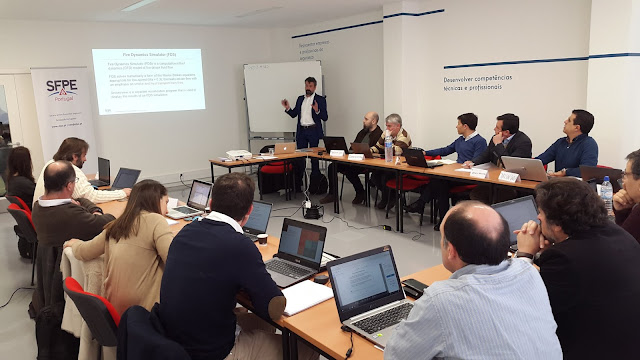The Murcia Fire Test Facility
The Murcia Fire Tests
Researchers from the University of Jaén, The University of Comillas (ICAI) with the collaboration of the Imperial College of London, MAPFRE and the fire consultancy JVVA Fire and Risk have undertaken several full scale fire tests in the Fire Atrium test facility in Murcia (Spain). The data obtained in the Murcia facility enables comparison of results from the empirical approaches, not only amongst themselves but against real test data, giving a better understanding of the difference between the predicted mass flow and that measured in the experiments. The test facility that has been used to perform the fire tests in an atrium is the Fire Atrium of the Centro Tecnológico del Metal (CTM), in Murcia, Spain. |
From left to right: Gabriele Vigne (1,3), Pablo Ayala (2), Cándido Gutiérez-Montes (2), Alexis Cantizano (1) (1) Universidad de Jaén (2) Universidad Comillas de Madrid (ICAI) (3) JVVA Fire & Risk |
The Murcia Fire Atrium is a full-scale facility consisting of a prismatic structure of 19.5 m x 19.5 m x 17.5 m and a pyramidal roof raised 2.5 m at the centre. The walls and roof are made of 6 mm thick steel sheets whilst the floor is made of concrete. The atrium is provided with four exhaust fans (with two velocity, provided by Sodeca) installed on the roof, each with a nominal flow rate of 9.2m3/s approximately. As per make up air, there are eight grilled vents arranged at the lower parts of the walls.
The burning fuel was heptane contained in circular steel pans placed at the centre of the atrium floor for an approximate HRR of 2MW and 4MW.
The atrium has been equipped with temperature, pressure and velocity sensors, in order to study the thermal and flow fields induced by the fire. Load cells have been installed top estimate the burning rate and consequently the HRR. Up to 60 sensors have been installed.
Measurements of walls and roof metal temperature, and air temperature at several locations (next to the walls, at a central section, through the exhaust fans and through the inlet vents) have been recorded. Differential and absolute pressure sensors at the exhaust fans have been also installed to check, from the fan performance curves, the mass and volume flow rate evacuated.
The smoke layer interface was measured by an aspiration detection system installed at different heights in the atrium (detection system provided by Xtralis).
The atrium has been equipped with temperature, pressure and velocity sensors, in order to study the thermal and flow fields induced by the fire. Load cells have been installed top estimate the burning rate and consequently the HRR. Up to 60 sensors have been installed.
Measurements of walls and roof metal temperature, and air temperature at several locations (next to the walls, at a central section, through the exhaust fans and through the inlet vents) have been recorded. Differential and absolute pressure sensors at the exhaust fans have been also installed to check, from the fan performance curves, the mass and volume flow rate evacuated.
The smoke layer interface was measured by an aspiration detection system installed at different heights in the atrium (detection system provided by Xtralis).
Measurements of walls and roof metal temperature, and air temperature at several locations (next to the walls, at a central section, through the exhaust fans and through the inlet vents) have been recorded. Differential and absolute pressure sensors at the exhaust fans have been also installed to check, from the fan performance curves, the mass and volume flow rate evacuated.
The smoke layer interface was measured by an aspiration detection system installed at different heights in the atrium (detection system provided by Xtralis).
The smoke layer interface was measured by an aspiration detection system installed at different heights in the atrium (detection system provided by Xtralis).
The Murcia Fire Atrium is a full-scale facility consisting in of a prismatic structure of 19.5 m x 19.5 m x 17.5 m and a pyramidal roof raised 2.5 m at the centre. The walls and roof are made of 6 mm thick steel sheets whilst the floor is made of concrete.
The old tests (2003-2008)
 |
| Picture of the Murcia Fire Facility |
The atrium was provided with four exhaust fans installed on the roof, each with a nominal flow rate of 3.8 m3/s approximately. As per make up air, there were eight grilled vents arranged at the lower parts of the walls.
The burning fuel was heptanes contained in a circular steel pans placed at the centre of the atrium floor. The pans wasere 25 cm deep with a diameter of 0.92 m. In all tests, a layer of 2 cm of water was added to the pan before the heptane was poured to insulate the metal from the burning pool heat, thus providing a more stable steady burning regime.
The test facility is property of the Centro Tecnológico del Metal (CTM), in Murcia, Spain. The Fire Atrium characteristics turn it into an ideal and unique facility in Spain for large scale fire tests.
 |
| Picture of the pool fire, 1.5 minutes after the ignition |
- Uncertainty of Smoke Filling Calculations in a Large Atrium through Comparison to Experimental Results, G.Vigne, C.Gutiérrez-Montes, G.Rein - 9th International Conference on Performance-Based Codes and Fire Safety Design to be held 20-22 June 2012 at the Excelsior, Hong Kong
- Assessment of Smoke Modelling techniques through Experimental Research and Numerical Analysis in Tunnels and Large Enclosures, MAst Thesis, Univeristy of Jaén, Spain, 8th of March 2012
- Gutiérrez-Montes, C.; Sanmiguel-Rojas, E.; S. Kaiser, A.; Viedma, A. Numerical model and validation experiments of atrium enclosure fire in a new fire test facility. Building and Environment, 2008, vol. 43(11), 1912–1928.
- Gutiérrez-Montes, C.; Sanmiguel-Rojas, E.; Viedma, A.; Rein, G. Experimental Data and Numerical Modelling of 1.3 and 2.3 MW Fires in a 20 m Cubic Atrium. Building and Environment.


Comments
Post a Comment